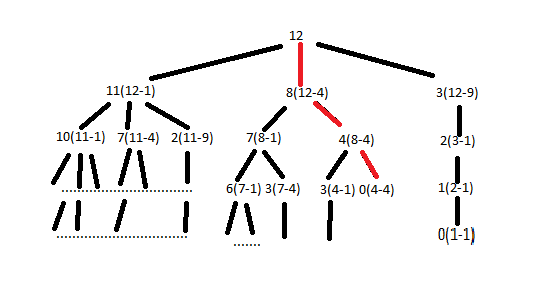https://leetcode.com/problems/perfect-squares/
Given a positive integer n, find the least number of perfect square numbers (for example, 1, 4, 9, 16, …) which sum to n.
Example 1:
Input: n = 12 Output: 3 Explanation: 12 = 4 + 4 + 4.
Example 2:
Input: n = 13 Output: 2 Explanation: 13 = 4 + 9.
动态规划
$$ f(i) = \min\{f(i - s)\} + 1, 其中 s 为平方数且 1 \le s \le i$$
class Solution {
public:
int numSquares(int n);
private:
static std::vector<int> &getNums();
static const int Max = std::numeric_limits<int>::max();
};
std::vector<int> &Solution::getNums() {
static std::vector<int> Nums{0};
return Nums;
}
int Solution::numSquares(int n) {
assert(n > 0);
auto &Nums = getNums();
if (Nums.size() > n)
return Nums[n];
for (int N, I, Diff, Num; (N = Nums.size()) <= n;) {
for (I = 1, Num = Max; (Diff = N - I * I) >= 0; ++I)
Num = std::min(Num, Nums[Diff] + 1);
Nums.push_back(Num);
}
return Nums[n];
}
宽度优先搜索

图片来自 Short Python solution using BFS - LeetCode Discuss
int Solution::numSquares(int n) {
assert(n > 0);
std::unordered_set<int> Set({n}), Tmp;
std::vector<int> Squares;
for (int I = 1, S; (S = I * I) <= n; ++I)
Squares.push_back(S);
for (int Level = 1; !Set.empty(); ++Level) {
for (const auto &N : Set) {
for (const auto &S : Squares) {
if (N == S)
return Level;
if (N < S)
break;
else
Tmp.insert(N - S);
}
}
Set.clear();
std::swap(Set, Tmp);
}
return -1;
}
筛法
灵感来源于埃拉托斯特尼筛法。Discuss 区翻了一下,好像没人提到过。
1 2 3 4 5 6 7 8 9 10 11 12 13 // numbers
1 1 1 // squares
2 2 2 2 2 // sums of 2 squares
3 3 3 3 3 // sums of 3 squares
4 // sums of 4 squares
先找出所有平方数,再依次筛选出 2 个、3 个、…、k 个平方数的和。实际上 k 是不会超过 4 的,下一节会提到。
int Solution::numSquares(int n) {
assert(n > 0);
std::vector<int> Nums(n + 1);
std::vector<int> Squares;
for (int I = 1, Square; (Square = I * I) <= n; ++I) {
Nums[Square] = 1;
Squares.push_back(Square);
}
if (Nums[n] != 0)
return 1;
std::vector<int> Pre = Squares, Cur;
for (int K = 2, Sum;; ++K) {
for (const auto &Square : Squares) {
for (const auto &I : Pre) {
if ((Sum = Square + I) > n || Nums[Sum] != 0)
continue;
Nums[Sum] = K;
Cur.push_back(Sum);
if (Sum == n)
return K;
}
}
std::swap(Pre, Cur);
Cur.clear();
}
}
四平方和定理
数学武器可以说是降维打击了。这里用到:
四平方和定理:任何自然数都可以表示为 4 个平方数之和
三平方和定理:对自然数 n ,当且仅当 n 无法表示为 $n = 4^a(8b + 7)$,其中 a、b 为整数,n 可以表示为 3 个平方数之和
由此可以推出:
如果自然数 n 是 4 的倍数,$\frac{n}{4}$ 的结果与其相同
当且仅当自然数 n 可以表示为 $n = 4^a(8b + 7)$ 时(a、b 为整数),n 只能表示为 4 个平方数之和
接下来只需判断 n 是否为 1 或 2 个平方数之和即可,如果不是则只能表示为 3 个平方数之和。
int Solution::numSquares(int n) {
assert(n > 0);
while (n % 4 == 0)
n /= 4;
if (n % 8 == 7)
return 4;
for (int I = 0, S, SE = n / 2, J; (S = I * I) <= SE; ++I) {
J = static_cast<int>(sqrt(n - S));
if (S + J * J == n)
return (I != 0) + (J != 0);
}
return 3;
}
时间复杂度 $O(\log(n))$,空间复杂度 $O(1)$。
实现源码
https://github.com/qianbinbin/leetcode
参考资料
- Summary of 4 different solutions (BFS, DP, static DP and mathematics) - LeetCode Discuss
- Short Python solution using BFS - LeetCode Discuss
- My solution different from DP, math or BFS algorithm - LeetCode Discuss
- 4ms C++ code - Solve it mathematically - LeetCode Discuss
- Lagrange’s four-square theorem - Wikipedia
- Legendre’s three-square theorem - Wikipedia
- Lagrange 四平方定理